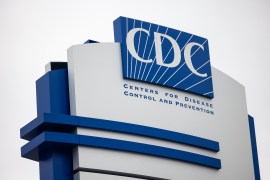Gone fishing? Depending on the lake, your catch may not be safe to eat.
A group of chemicals collectively known as PFAS are found in hundreds of consumer goods, including dental floss, rain jackets and nonstick cookware. Over decades, these chemicals have spewed from manufacturing plants and landfills into local ecosystems, polluting surface water and groundwater, as well as the wildlife living there.
PFAS, or perfluoroalkyl and polyfluoroalkyl substances, are called “forever chemicals” because they don’t break down quickly in the environment, instead accumulating in soil, water, fish and our bodies. Hundreds of military bases have been pinpointed as sources of PFAS leaching into nearby communities’ groundwater.
In 2022, the National Academies of Sciences, Engineering and Medicine published a sweeping federally funded report that associated PFAS exposure with health issues such as cancer, low birth weight and decreased responses to vaccines.
Federal efforts to curb PFAS exposure have focused mostly on drinking water. In March, the Environmental Protection Agency proposed the nation’s first PFAS drinking water standards, which would limit contamination from six types of chemicals. Levels for the two most common compounds would be set at just four parts per trillion. The agency says it expects to finalize the rule early this year.
But some scientists worry that regulations for freshwater fish are lagging. A recent study from The Environmental Working Group found that just one serving of fish can be equivalent to a month of drinking water contaminated with 48 parts per trillion of the common chemical PFOS.
“PFAS in freshwater fish is at such a concentration that for anyone consuming, even infrequently, it would likely be their major source of exposure over the course of the year,” said David Andrews, a co-author of the study and researcher at EWG. “We’re talking thousands of times higher than what’s typically seen in drinking water.”
At least 17 states have issued PFAS-related fish consumption advisories, KFF Health News found, with some warning residents not to eat any fish caught in particular lakes or rivers because of dangerous levels of contamination.
But there’s no federal guidance on the matter. So, what’s considered safe to eat varies significantly among states — and most provide no regulation. “Do not eat” thresholds for the general population range from 25.7 parts per billion in New Hampshire to 800 ppb in Alabama.
Levels for children, pregnant people and other “at-risk” groups are usually lower.
That’s especially unnerving for rural, Indigenous and low-income communities that depend on subsistence fishing. Fish are a large part of many communities’ diets, and aside from forever chemicals — and in some species, mercury — they’re a healthy source of protein and omega-3 fatty acids.
The regulatory picture is changing fast, however. For example, on Dec. 8, Maryland updated its fish consumption guidance for PFAS to cover 15 species in 71 advisories. Previously, the state had just one advisory from 2021 for Piscataway Creek, which flows out of Joint Base Andrews just outside of D.C.
The state’s new guidance is almost 10 times more stringent. The concentration of PFOS in fish that would warrant an “avoid” recommendation for the general population is now 41 parts per billion, according to Maryland spokesperson Jay Apperson, compared with 408 ppb before the December update.
This shifting science has big consequences for anglers. Up until December, Maryland said the general population could eat three largemouth bass meals per month from Piscataway Creek. Now, it says no one should eat any of the creek’s bass or sunfish.
While the EPA has tested hundreds of fish for PFAS and found some samples with concerningly high concentrations, it has no plans to provide national fish consumption advisories.
“For people who eat freshwater fish caught in local rivers and lakes, EPA recommends that they consult their state, tribe or territory for information on local fish advisories to determine the safe number of freshwater fish to eat,” EPA spokesperson Remmington Belford said in an email.
However, the EPA added hundreds of PFAS compounds to its list of “chemicals of special concern” last year, requiring manufacturers to start reporting their inclusion in products, even in small amounts or in mixtures, as of Monday. And the EPA plans to publish a list of which PFAS chemicals to watch for in state, tribe and territory fish advisory programs in early 2024. (That list had been expected last spring.)
If there’s any good news, it’s that the Food and Drug Administration tested saltwater fish and shellfish sold in grocery stores — including Atlantic salmon and canned tuna — and generally found far lower levels of PFAS contamination.
This article is not available for syndication due to republishing restrictions. If you have questions about the availability of this or other content for republication, please contact NewsWeb@kff.org.






